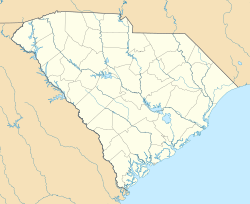Hagood Mill facts for kids
Quick facts for kids |
|
|
Hagood Mill
|
|
 |
|
| Location | 138 Hagood Mill Road |
|---|---|
| Nearest city | Pickens, South Carolina |
| Area | 8 acres (3.2 ha) |
| Built | 1826, 1845 |
| Built by | Hagood, Benjamin Hagood, James E. |
| NRHP reference No. | 72001217 |
| Added to NRHP | December 11, 1972 |
The Hagood Mill is a special old mill that still works today. It uses water power to grind grain, like corn, into flour. James Hagood built this mill in 1845 near Pickens, South Carolina. It is a very important historical place. Because of its history, it was added to the National Register of Historic Places in 1972.
Contents
The Mill's Story
The Hagood Mill is located next to Hagood Branch. This small stream was once called Jennings Creek. It flows into the Twelve Mile River. People have used mills on this spot since the 1790s. The mill you see today was built in 1845 by James Hagood.
The Hagood family owned and operated the mill for a long time. It kept working until 1966. At that time, new rules made it difficult for small mills to operate. These rules required special testing for corn before it could be ground. This change caused many small mills in Pickens County to close.
In the past, the mill and a nearby store were important gathering spots. People from all over the county would come here. They would grind their grain and also meet up with friends and neighbors.
Saving the Mill
In 1973, the mill and the land around it were given to the Pickens County Museum. This helped to protect the historic site. The mill's water wheel and other parts were rebuilt in the mid-1970s. Workers used many of the original pieces that were still good.
Later, in the 1990s, a local historian named Alan Warner helped restore the mill again. He was also a miller, someone who operates a mill. Thanks to these efforts, the Hagood Mill can still grind grain today.
How the Mill Works
The mill building from 1845 is made of hand-cut logs. It has two stories and is covered with wooden siding. It does not have any paint on it.
Water from the creek powers the mill. Long ago, water was sent through a ditch called a headrace. This ditch was about 1,650 feet long. Today, water is pumped underground from the creek to the headrace. The last 80 feet of the headrace are made of wood.
The large wooden water wheel is called an "overshot" wheel. This means water flows over the top of the wheel to make it turn. The wheel is 20 m (66 ft) tall and 4 feet wide. It is very powerful, making 22 horsepower. A huge gear, 18 feet wide, helps turn the millstones. There are two granite millstones, and each one weighs about 1,600 pounds!
Hagood Mill Historic Site & Folklife Center
The Hagood Mill is the main attraction at the Hagood Mill Historic Site & Folklife Center. But there is much more to see and learn about here! The site helps people understand what life was like long ago.
What Else to Explore
- Historic Cabins: You can see two old cabins that show how people lived.
- Blacksmith Shop: This is where a blacksmith would make and repair metal tools.
- Moonshine Still: There is a historical piece of equipment used in the past.
- Cotton Gin: This machine was used to separate cotton fibers from their seeds.
- Hagood Creek Petroglyph Site: This special area has ancient rock carvings made by Native Americans. These carvings are very important for understanding history.
- Prater's Creek Bridge: This steel bridge is 64 feet (20 m) long. It was built in 1930 by the Greenville Steel and Foundry Company. It was moved to the Hagood Mill site in 2007.
The Hagood Mill Historic Site & Folklife Center is a great place to visit. You can learn about old ways of life and see how things were done in the past.



